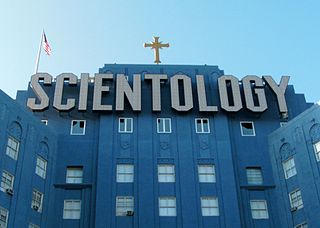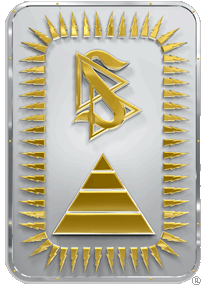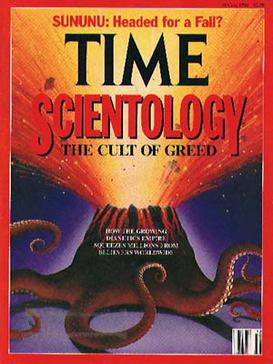
Dianetics is a set of pseudoscientific ideas and practices regarding the metaphysical relationship between the mind and body created by science fiction writer and Scientology founder L. Ron Hubbard. Dianetics is practiced by followers of Scientology and the Nation of Islam.

The Free Zone, Freezone, or more recently identified as Independent Scientology, comprises a variety of non-affiliated independent groups, organizations, and individuals who practice Scientology beliefs and techniques independently of the Church of Scientology (CoS). Such practitioners range from those who closely adhere to the original teachings of Scientology's founder, L. Ron Hubbard, to those who have adapted their practices far from CoS beliefs and practices.

The Church of Scientology maintains a wide variety of beliefs and practices. The core belief holds that a human is an immortal, spiritual being (thetan) that is resident in a physical body. The thetan has had innumerable past lives, some of which, preceding the thetan's arrival on Earth, were lived in extraterrestrial cultures. Based on case studies at advanced levels, it is predicted that any Scientologist undergoing auditing will eventually come across and recount a common series of past-life events.

Since its inception in 1954, the Church of Scientology has been involved in a number of controversies, including its stance on psychiatry, Scientology's legitimacy as a religion, the Church's aggressive attitude in dealing with its perceived enemies and critics, allegations of mistreatment of members, and predatory financial practices; for example, the high cost of religious training:191 and perceived exploitative practices. When mainstream media outlets have reported alleged abuses, representatives of the church have tended to deny such allegations.

The E-meter, originally the electropsychometer, is an electronic device for displaying the electrodermal activity (EDA) of a human being. It is used for auditing in Scientology and divergent groups. The efficacy and legitimacy of Scientology's use of the E-meter has been subject to extensive litigation, and, in accordance with a federal court order, the Church of Scientology publishes disclaimers declaring that the E-meter "by itself does nothing", is incapable of improving health, and is used specifically for spiritual purposes.
The reactive mind is a concept in the Scientology religion formulated by L. Ron Hubbard, referring to that portion of the human mind that is unconscious and operates on stimulus-response, to which Hubbard attributed most mental, emotional, and psychosomatic ailments:
What can it do? It can give a man arthritis, bursitis, asthma, allergies, sinusitis, coronary trouble, high blood pressure and so on, down the whole catalog of psychosomatic ills, adding a few more which were never specifically classified as psychosomatic, such as the common cold.

The Religious Technology Center (RTC) is an American non-profit corporation that was founded in 1982 by the Church of Scientology to control and oversee the use of all of the trademarks, symbols and texts of Scientology and Dianetics. Although RTC controls their use, those works are owned by another corporation, the Church of Spiritual Technology which is doing business as L. Ron Hubbard Library, registered in Los Angeles County, California.

The term fair game is used to describe policies and practices carried out by the Church of Scientology towards people and groups it perceives as its enemies. Founder of Scientology, L. Ron Hubbard, established the policy in the 1950s, in response to criticism both from within and outside his organization. Individuals or groups who are "fair game" are judged to be a threat to the Church and, according to the policy, can be punished and harassed using any and all means possible. In 1968, Hubbard officially canceled use of the term "fair game" because of negative public relations it caused, although the Church's aggressive response to criticism continued.

Dianetics: The Modern Science of Mental Health, sometimes abbreviated as DMSMH, is a book by L. Ron Hubbard about Dianetics, a system that he developed from a combination of personal experience, basic principles of Eastern philosophy and the work of Sigmund Freud, the founder of psychoanalysis. The book is a canonical text of Scientology. It’s colloquially referred to as Book One. The book launched the movement, which later defined itself as a religion, in 1950. As of 2013, New Era Publications, the international publishing company of Hubbard's works, sells the book in English and in 50 other languages.

"The Thriving Cult of Greed and Power" is an article, written in 1991 by U.S. investigative journalist Richard Behar, which is highly critical of Scientology. It was first published by Time magazine on May 6, 1991, as an eight-page cover story, and was later published in Reader's Digest in October 1991. Behar had previously published an article on Scientology in Forbes magazine. He stated that he was investigated by attorneys and private investigators affiliated with the Church of Scientology while researching the Time article, and that investigators contacted his friends and family as well. Behar's article covers topics including L. Ron Hubbard and the development of Scientology, its controversies over the years and history of litigation, conflict with psychiatry and the U.S. Internal Revenue Service, the suicide of Noah Lottick, its status as a religion, and its business dealings.

The Church of Scientology is a group of interconnected corporate entities and other organizations devoted to the practice, administration and dissemination of Scientology, which is variously defined as a cult, a business, or a new religious movement. The movement has been the subject of a number of controversies, and the Church of Scientology has been described by government inquiries, international parliamentary bodies, scholars, law lords, and numerous superior court judgements as both a dangerous cult and a manipulative profit-making business. In 1979, several executives of the organization were convicted and imprisoned for multiple offenses by a U.S. Federal Court. The Church of Scientology itself was convicted of fraud by a French court in 2009, a decision upheld by the supreme Court of Cassation in 2013. The German government classifies Scientology as an unconstitutional sect. In France, it has been classified as a dangerous cult. In some countries, it has attained legal recognition as a religion.

History of Dianetics and Scientology begins around 1950. During the late 1940s, L. Ron Hubbard began developing a mental therapy system which he called Dianetics. Hubbard had tried to interest the medical profession in his techniques, including the Gerontological Society, the Journal of the American Medical Association, and the American Journal of Psychiatry, but his work was rejected for not containing sufficient evidence of efficacy to be acceptable.

A Piece of Blue Sky: Scientology, Dianetics and L. Ron Hubbard Exposed is a 1990 book about L. Ron Hubbard and the development of Dianetics and Scientology, authored by British former Scientologist Jon Atack. It was republished in 2013 with the title Let's sell these people A Piece of Blue Sky: Hubbard, Dianetics and Scientology. The title originates from a quote of Hubbard from 1950; an associate of Hubbard's noted him saying that he wanted to sell potential members "a piece of blue sky".

This is a Timeline of Scientology, particularly its foundation and development by author L. Ron Hubbard as well as general publications, articles, books and other milestones.
The Church of Scientology publicly classifies itself as a religion, but scholars and other observers regard it as a business, because the organization operates more like a for-profit business than a religious institution. Some scholars of sociology working in religious studies consider it a new religious movement. Overall, as stated by Stephen A. Kent, Scientology can be seen as a "multi-faceted transnational corporation that has religion as only one of its many components. Other components include political aspirations, business ventures, cultural productions, pseudo-medical practices, pseudo-psychiatric claims, and, an alternative family structure."

Scientology Missions International (SMI) is a Californian 501(c)(3) non-profit corporation, which is located in Los Angeles, California. SMI is part of the Church of Scientology network.

Scientology is a set of beliefs and practices invented by the American author L. Ron Hubbard, and an associated movement. It is variously defined as a cult, a business, or a new religious movement. Hubbard initially developed a set of ideas that he called Dianetics, which he represented as a form of therapy. An organization that he established in 1950 to promote it went bankrupt, and Hubbard lost the rights to his book Dianetics in 1952. He then recharacterized his ideas as a religion, likely for tax purposes, and renamed them Scientology. By 1954, he had regained the rights to Dianetics and founded the Church of Scientology, which remains the largest organization promoting Scientology. There are practitioners independent of the Church, in what is called the Free Zone. Estimates put the number of Scientologists at under 40,000 worldwide.

Scientology in the United Kingdom is practised mainly within the Church of Scientology and its related groups which go under names including "Hubbard Academy of Personal Independence" and "Dianetics and Scientology Life Improvement Centre". The national headquarters, and former global headquarters, is Saint Hill Manor at East Grinstead, which for seven years was the home of L. Ron Hubbard, the pulp fiction author who created Scientology. In the 2021 census, there were 1,844 individuals in England and Wales who listed themselves as Scientologists in their census returns, almost half of which lived in the area around East Grinstead in West Sussex, which hosts the British Scientology Headquarters at Saint Hill Manor. This is a decline of just under a quarter since census day, 2011.






